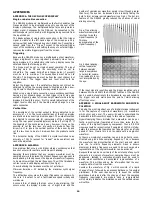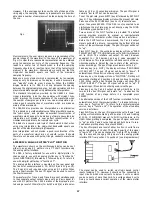
13
pressing both keys simultaneously.
Post trigger time delay can be used to expand a small sec-
tion of a waveform (as in a sweep-delay oscilloscope). Set
a delay of +0002 so that the peak of the sinewave is
within the first division of the screen. Now increase the
timebase to 5usec/div, note that the delay is increased to
+0008 divs so as to maintain a constant time delay thus
keeping the sinewave peak within the trace area.
Note that time delay is not available in RPT mode, and
that only post trigger time delay is available in ROLL
mode. Time delay is automatically set to zero whenever
the timebase is set into RPT or ROLL.
2.
EVENTS DLY (events delay) This function enables the
triggering of the digitising to be delayed by up to 15
trigger events. See the reference section of the manual for
a full explanation.
More about Roll Mode
(Start with the DSA reset and the generator set to SINE, 20kHz,
5V pk-pk.)
Because in roll mode the waveform data is written continuously
onto the display, it is not necessary to continually stop and
restart the digitising process. Consequently when RUN/HOLD is
set to RUN, digitising takes place continuously and triggering is
disabled.
The purpose of triggering is to enable a specific part of a wave-
form to be captured. In normal modes the digitising period is
always 40 divisions, so defining the trigger point automatically
defines the part of the waveform that will be captured. In roll
mode the digitising period is not limited to 40 divisions but con-
tinues indefinitely.
There are two possible ways in which a triggered roll mode can
be provided. The trigger could start the roll which could then
continue for 40 divisions, but this would have the disadvantage
that pre-trigger data could not be captured. Alternatively, the roll
could run continuously until stopped by the trigger, this is the
system employed in the DSA524 when SINGLE is used.
1.
Set the generator frequency to 2Hz and the DSA timebase
to 200ms/div. Select DC input coupling.
2.
Set RUN /HOLD to HOLD, ensure that the trigger mode is
AUTO and that TIME DLY is off. Now press SINGLE, note
that although the roll starts, it stops again immediately.
This is because in AUTO mode triggering occurs auto-
matically after a very short delay.
3.
Now set TIME DLY to +0005 divisions. Press SINGLE and
note that the roll stops after 5 divisions of data has been
captured.
4.
Set TIME DLY back to zero and set the trigger mode to
NORM. Press SINGLE and note that a small section of the
waveform prior to the trigger level point has been cap-
tured. Thus the waveform occurring between SINGLE
being pressed and the trigger occurring has been
captured.
Note that in roll mode SINGLE, all the data in the digitising
memory is pre-trigger data unless some post-trigger time delay
has been set. Pre-trigger time delay is therefore not needed and
is disabled.
Similarly, when in roll mode the display always shows the last
section of the digitising memory rather than the first. Therefore
when SEARCH mode is selected, the SCAN window is initially set
fully right instead of fully left.
Memory Search
(Start with the DSA reset and the generator set to SINE, 20kHz,
5V pk-pk.)
Although the screen shows only 1024 words (10.24
divisions) for each trace, the digitising memory captures
4096 words (40.96 divisions) per channel. The SEARCH
key enables the whole of the digitising memory to be
accessed. It also provides digital magnification by ten
(using linear interpolation).
1.
Press SEARCH once, the COMP (compress) lamp will illu-
minate and a filled bar will appear at the top of the
screen for 3 seconds (the filled bar represents the 4K of
the memory). Note that the waveform is compressed by
a factor of four, thus allowing the whole of the digitising
memory to be displayed (this is achieved by displaying
every fourth word).
2.
Press SEARCH again, the SCAN lamp will illuminate and
a bar will appear at the top of the screen with the first
quarter filled (this bar represents the 4K of the memory
and the filled section represents the 1K which is being
displayed). Note that the waveform returns to normal
and that the bar disappears after 3 seconds.
Press the key marked SCAN /MAG which has a right-
hand arrow, note that the bar reappears. Press the key
again, note that the waveform appears to r 'love to the
left by one division and that the filled section of the bar
moves to the right. The filled section can be regarded as
the "scan window" which shows which 1K section of the
4K memory is being displayed.
Try moving the scan window backwards and forwards
using the two arrow keys. Note that the keys only move
the window whilst the bar is being displayed, otherwise
the first press merely brings up the bar in order to show
the present position.
3.
Press SEARCH again, the MAG light will illuminate and a
bar will appear with the first one tenth filled (the bar
represents the present position of the scan window and
the filled section represents the 102 words which are
being magnified to fill the screen, this can be regarded
as the magnify window). Note that the waveform
becomes magnified by x10 and that the bar disappears
after 3 seconds.
Try moving the magnify window backwards and
forwards using the two arrow keys. Note that this works
in just the same way as with the scan window.
4.
Press SEARCH several times and note how it cycles
through the COMP, SCAN and MAG functions. Press the
two SCAN /MAG keys simultaneously in order to turn
search off.
Display Update Rate
(Start with the DSA reset and the generator set to SINE, 20kHz,
5V pk-pk.)
The rate at which digitising is repeated and the display is
updated can be varied using the key marked RATE. When the
rate is set to normal (SLOW and FAST lamps both off) there is a
delay of about 0.3 seconds before digitising is restarted when in
RUN mode. This delay can be increased to about 3 seconds or
reduced to about 0.03 seconds.
The RATE key only operates with timebase speeds between
100ms/div and 5us/div, it has no effect in ROLL or RPT modes.
1.
Press the RATE key (the SLOW lamp will illuminate) and
vary the generator output. Note that the screen is
updated only about once every 3 seconds instead of
about 3 times per second. This gives enough time for
each digitising to be observed and for the display to be
"held" before the waveform is lost and replaced with a
new one. Press RATE again to return to normal update
rate.
2.
Press the RATE key and hold it depressed for 2 seconds
(the FAST lamp will be illuminated) and vary the
generator output. Note that the screen is updated very
quickly providing a near instant response to waveform
changes similar to a conventional oscilloscope. Press
RATE again to return to normal update rate.
























